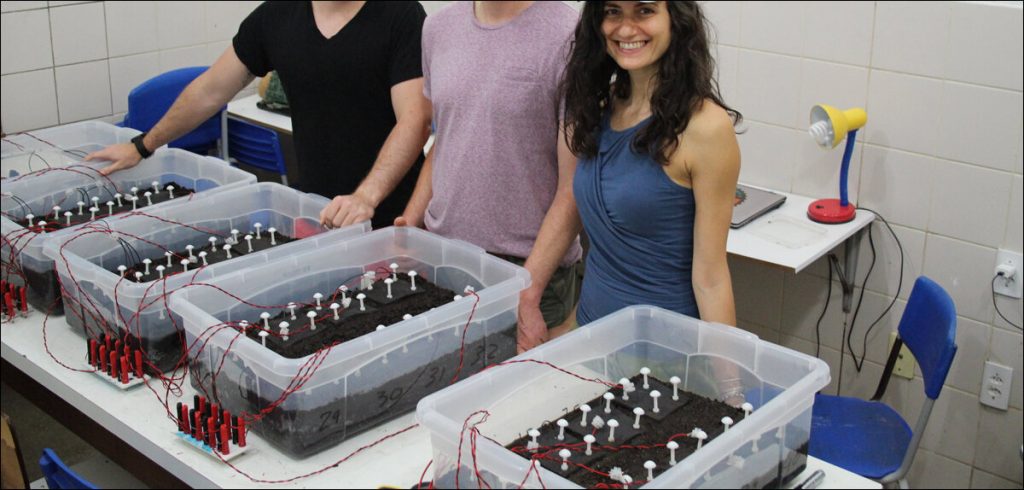Remove the need for expensive solar panels and a long trip around a 100-acre farm swapping out batteries and you make this a lot more accessible.
There are approximately 15.14 billion IoT devices in the world today, give or take a few billion. If you consider the fact that a decent amount of these are probably sensors running on batteries, that’s an ecological disaster in the making. With the amount of toxic substances that are going to leak out into the soil, the ocean, or the air when those batteries finally run out, we need to start looking at eco-friendly alternatives.
If you’re thinking solar, solar still needs batteries that are made from rare-earth metals that are either mined with machines that run on fossil fuels or people who are made to slave away in inhuman conditions in conflict-affected regions. The answer? A battery that runs on dirt and doesn’t run out.

Microbial Fuel Cells
In a previous post, we looked at bacteria that generate electricity when they break down wastewater. Similarly, soil contains bacteria that naturally donate electrons to semiconducting materials when they break down carbon and nutrients in the soil. The problem, however, is that while the concept has been around since 1911, it has been mostly shelved due to complications that arise when you try to keep a battery buried in the dirt and also constantly supplied with oxygen and water.
If you’re thinking an oxygen tank would work, remember these aren’t batteries designed to power phones or cars but rather IoT devices or the sensors that they are equipped with. Keeping that in mind, the solution to the problem needed to be something cheap, quick, and easy to reproduce.

(Image Credit: Bill Yen / Northwestern University)
That’s exactly what a team of researchers at Northwestern University Illinois came up with by discarding the traditional fuel cell shape and going with a fresh design, specifically for a dirt-fueled cell. While traditional fuel cells are square-shaped with two rods at each end, a cathode, an anode, and a membrane in the middle, this one is nothing like that.
The team of researchers spent two years perfecting this particular design and even created four different versions and tested them over nine months to see which one works best in both dry and water-logged conditions. The winning design features a setup where a square plate acts as a cathode sitting straight on top of a circle-shaped anode made of carbon felt that lies flat on the ground.

The winning design
Now we already mentioned the problem of keeping microbial fuel cells supplied with water and oxygen when they’re buried in the dirt. With this particular design, however, while the anode is buried in the dirt and collecting electrons from bacteria, the cathode sits vertically and perpendicular to the anode in a cartridge-shaped frame.
What the frame does is make sure the dirt doesn’t close in on the anode, cutting off the air supply and the fact that the anode is the base of the fuel cell ensures that even if the top soil gets dry, the anode is deep enough to stay damp. The cartridge-shaped frame comprises a custom flange, scaffold, and 3D-printed cap designed to keep the airways open and free of debris.

The dirt-powered fuel cell also features onboard moisture and touch detection sensors, as well as a tiny antenna to transmit the data collected from those sensors. Surprisingly, in both water-logged and almost dry (41% water by volume in soil), the fuel cell produced 68% more electricity than it used to power its sensors and antenna.
That’s a major game-changer as far as agricultural IoT devices go, most of which are used to monitor soil, moisture, and movement. Remove the need for expensive solar panels and a long trip around a 100-acre farm swapping out batteries and you make the technology a lot more accessible. Additionally, all the components of this particular design can be bought off-the-shelf at a hardware store.

(Image Credit: Bill Yen / Northwestern University)

Dirt is not dirty
In conclusion, there are going to be an estimated 41 billion IoT devices by next year. With governments across the world promoting and providing subsidies for more efficient farming techniques like sensor-based soil monitoring, the agricultural IoT market is set to hit $18 billion in just two years. Since sensors sitting in the middle of a field are probably going to be far away from a power source, it’s a good thing someone is worried about finding a clean, efficient, and cheap way to keep all those sensors powered for possibly decades at a time, if not indefinitely.
To quote one of the lead researchers on the project Bill Yen, “If we imagine a future with trillions of these devices, we cannot build every one of them out of lithium, heavy metals, and toxins that are dangerous to the environment.“
In case you missed:
- Toyota’s Liquid Hydrogen-Powered “GR H2” Race Cars
- Researchers develop solar cells to charge phones through their screens
- Could Dimming the Sun Be the Solution to Global Warming?
- What Is Electronic Soil?
- South Korean firm develops drone that flies on hydrogen fuel
- Scientists gave a mushroom robotic legs and the results may frighten you
- Age reversal technologies in 2024, longevity escape velocity by 2029?
- California startup develops app to sell sunshine at night
- These AI powered devices add smells to virtual worlds
- How AI Is Helping Restore the World’s Coral Reefs









